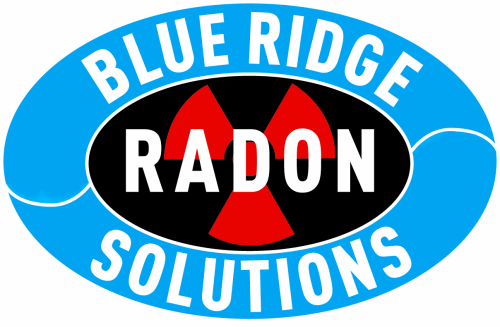
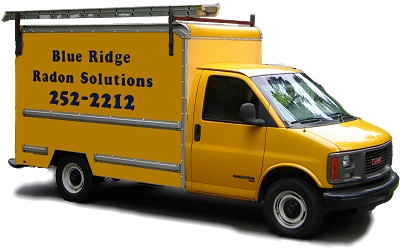 Radon Facts…
Radon Facts…
Radon is estimated by the American Lung Association to be the second leading cause of lung cancer in the U.S. today, causing thousands of deaths each year. Radon is an invisible, odorless, radioactive gas that has been found in homes all over the U.S. It comes from the natural breakdown of uranium in soil, rock and water and gets into the air we breathe. Radon typically moves up through the ground to the air above and into your home through cracks and other holes in the foundation. Your home can trap radon inside. Sometimes radon enters the home through well water.
Any home can have a radon problem.
This means new and old homes, well-sealed and drafty homes, and homes with or without basements. In fact, you and your family are most likely to get your greatest radiation exposure at home. That is where you spend most of your time.
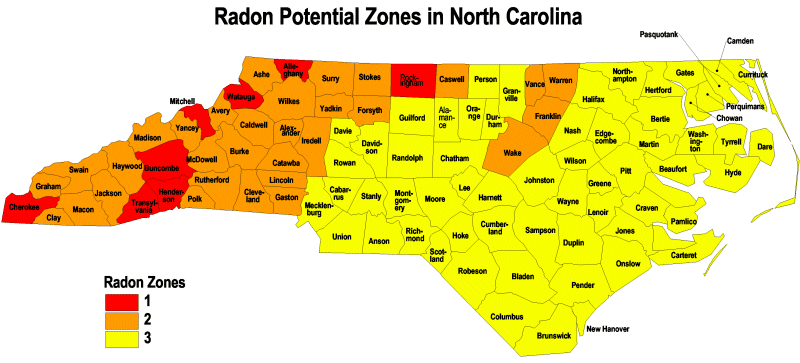
EPA and the Surgeon General
Recommend that you test your home…
Testing is the only way to know if you and your family are at risk from Radon. EPA and the Surgeon General recommend testing all homes below the third floor for Radon.
What is Radon?
- Radon is a radioactive gas. It is colorless, odorless, tasteless, and chemically inert. Unless you test for it, there is no way of telling how much is present.
- Radon is formed by the natural radioactive decay of uranium in rock, soil, and water. Naturally existing, low levels of uranium occur widely in Earth’s crust. It can be found in all 50 states. Once produced, radon moves through the ground to the air above.
- Radon gas decays into radioactive particles that can get trapped in your lungs when you breathe. As they break down further, these particles release small bursts of energy. This can damage lung tissue and lead to lung cancer over the course of your lifetime. Not everyone exposed to elevated levels of radon will develop lung cancer, and the amount of time between exposure and the onset of the disease may be many years.
- The Surgeon General has warned that radon is the second leading cause of lung cancer in the United States. Radon is responsible for about 21,000 lung cancer deaths every year.
How Radon Enters Your Home
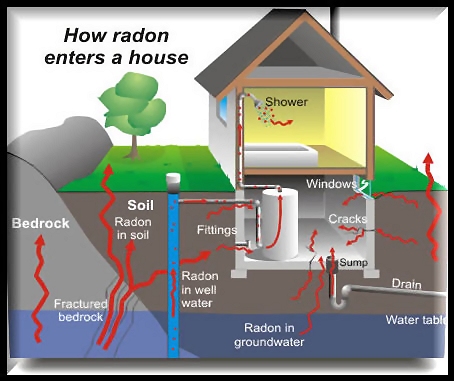 Radon gas enters the home through the slab, basement, or crawl space. Pressure differences within the home (from warm air rising and other natural effects) pull radon into living spaces from the soil. Furnace & air conditioning systems can distribute the air through the structure.
Radon gas enters the home through the slab, basement, or crawl space. Pressure differences within the home (from warm air rising and other natural effects) pull radon into living spaces from the soil. Furnace & air conditioning systems can distribute the air through the structure.
While sealing may be a necessary part of the radon mitigation process, the EPA does not recommend the use of sealing alone to reduce radon because by itself, sealing has not been shown to lower radon levels significantly or consistently.
Any home may have a radon problem, new or old with or without a basement, sealed basement or not.
Radon from soil gas is the main cause of radon problems. Other less common sources include well water and building materials. Measuring radon concentration in the air is recommended for initial testing.
Radon Myths
 MYTH: Scientists are not sure that radon really is a problem.
MYTH: Scientists are not sure that radon really is a problem.
 FACT: Although some scientists dispute the precise number of deaths due to radon, all major health organizations (like the Centers for Disease Control and Prevention, the American Lung Association and the American Medical Association) agree with estimates that radon causes thousands of preventable lung cancer deaths every year. This is especially true among smokers, since the risk to smokers is much greater than to non-smokers.
FACT: Although some scientists dispute the precise number of deaths due to radon, all major health organizations (like the Centers for Disease Control and Prevention, the American Lung Association and the American Medical Association) agree with estimates that radon causes thousands of preventable lung cancer deaths every year. This is especially true among smokers, since the risk to smokers is much greater than to non-smokers.
 MYTH: Radon testing is difficult, time-consuming and expensive.
MYTH: Radon testing is difficult, time-consuming and expensive.
 FACT: Radon testing is easy. You can test your home yourself or hire a qualified radon test company. Either approach takes only a small amount of time and effort.
FACT: Radon testing is easy. You can test your home yourself or hire a qualified radon test company. Either approach takes only a small amount of time and effort.
 MYTH: Radon testing devices are not reliable and are difficult to find.
MYTH: Radon testing devices are not reliable and are difficult to find.
 FACT: Reliable testing devices are available from qualified radon testers and companies. Reliable testing devices are also available by phone or mail-order, and can be purchased in hardware stores and other retail outlets. Call your state radon office for help in identifying radon testing companies.
FACT: Reliable testing devices are available from qualified radon testers and companies. Reliable testing devices are also available by phone or mail-order, and can be purchased in hardware stores and other retail outlets. Call your state radon office for help in identifying radon testing companies.
 MYTH: Homes with radon problems can’t be fixed.
MYTH: Homes with radon problems can’t be fixed.
 FACT: There are simple solutions to radon problems in homes. Hundreds of thousands of homeowners have already fixed radon problems in their homes. Radon levels can be readily lowered (with a typical cost of $1,200). Call your state radon office for help in identifying qualified mitigation contractors.
FACT: There are simple solutions to radon problems in homes. Hundreds of thousands of homeowners have already fixed radon problems in their homes. Radon levels can be readily lowered (with a typical cost of $1,200). Call your state radon office for help in identifying qualified mitigation contractors.
 MYTH: Radon affects only certain kinds of homes.
MYTH: Radon affects only certain kinds of homes.
 FACT: House construction can affect radon levels. However, radon can be a problem in homes of all types: old homes, new homes, drafty homes, insulated homes, homes with basements, and homes without basements. Local geology, construction materials, and how the home was built are among the factors that can affect radon levels in homes.
FACT: House construction can affect radon levels. However, radon can be a problem in homes of all types: old homes, new homes, drafty homes, insulated homes, homes with basements, and homes without basements. Local geology, construction materials, and how the home was built are among the factors that can affect radon levels in homes.
 MYTH: A neighbor’s test result is a good indication of whether your home has a problem.
MYTH: A neighbor’s test result is a good indication of whether your home has a problem.
 FACT: It’s not. Radon levels can very greatly from home to home. The only way to know if your home has a radon problem is to test it.
FACT: It’s not. Radon levels can very greatly from home to home. The only way to know if your home has a radon problem is to test it.
 MYTH: It’s difficult to sell homes where radon problems have been discovered.
MYTH: It’s difficult to sell homes where radon problems have been discovered.
 FACT: Where radon problems have been fixed, home sales have not been blocked or frustrated. The added protection is some times a good selling point.
FACT: Where radon problems have been fixed, home sales have not been blocked or frustrated. The added protection is some times a good selling point.
 MYTH: I’ve lived in my home for so long, it doesn’t make sense to take action now.
MYTH: I’ve lived in my home for so long, it doesn’t make sense to take action now.
 FACT: You will reduce your risk of lung cancer when you reduce radon levels, even if you’ve lived with a radon problem for a long time. If you sell your home you will typically be asked to install a radon system by the buyer if levels are 4.0 pCi/l or higher.
FACT: You will reduce your risk of lung cancer when you reduce radon levels, even if you’ve lived with a radon problem for a long time. If you sell your home you will typically be asked to install a radon system by the buyer if levels are 4.0 pCi/l or higher.
Radon Mitigation Questions & Answers
Are there other benefits to a Radon Mitigation system other than the removal of radon?
An active radon reduction system reduces the entry into the home of radon, other soil gases and moisture, making the home healthier and reducing the likelihood of moisture-related new-home problems such as warping wood, odors and mold or mildew. After installing an active radon system, a certified radon mitigation contractor will provide a radon reduction guarantee. An active system:
- Improves indoor air quality
- Reduces radon, moisture, odor, allergens
- Provides a more comfortable living environment
- Adds more livable space
- Preserves the building’s structure
- Protects interior fit and finish
Do RRNC and Passive Systems Reduce Radon?
A passive system or RRNC might provide a small reduction in radon levels because of the natural convection of heat rising within the home, (stack effect), but an active system will reduce radon in nearly every new home. The risk to homeowners when they buy a home with RRNC or passive system is that both terms give the impression that a home is safe from radon. A home with RRNC or a passive radon system is a great step forward but not guaranteed to resist radon until activated with an inline fan.
These two simple and relatively inexpensive additional steps will make a passive or RRNC system active:1. Add a radon fan.
2. Test the radon level.
Are there special considerations for my home?
- Homes built since the 1980s
Frequently have a gravel bed under the concrete slabs, which creates a great opportunity for air flow. System design in these homes is almost exclusively aesthetics and the fan choice is a very energy efficient, lower suction fan.
- Homes built before the 1970s
Likely these have slabs poured directly onto soil, frequently compacted soil, or clay, which may lead to decreased air flow and special mitigation considerations. These special needs have a larger effect on system design and may benefit from the use of a high suction fan.
- Slab areas greater than 2,000 + sq feet.
These homes may require special design considerations, and system design may include or combine, larger piping, multiple penetrations or multiple systems. Fan selection is based upon both the pressure field extension and sub slab materials.
More often than not, proper mitigation will require addressing the whole building. If the home has more than one foundation type or level, (or crawl space) the system design may need to incorporate the full slab with additional pipe extensions into other slab areas.
What is the cost of running a mitigation system?
Radon fans run continuously, however, with proper installation, design, and sealing of the basement slab. Most system’s average energy cost should be less than $50 a year.
We maximize energy efficiency by creating the best possible airflow under the slab, and by sealing basement floor cracks.
How much is a typical Radon mitigation system?
Standard radon mitigation systems from professional, certified, licensed and insured contractors in Western North Carolina have an average cost of $1300.00
What increases the average cost of installing a radon system?
If the home requires excessive sealing, larger more expensive fans, extra suction holes, or the treatment of a crawl space, the system price will increase accordingly, with crawl spaces bringing the largest price change.
Are Radon systems noisy?
Most radon systems are barely audible, however design considerations may be necessary to limit noise transfer from the radon system into the interior for some of the higher air flow fans. If noise is a concern, please consult a professional NRPP certified Radon Mitigation Technician about noise before making a decision on system design.
What about sealing my basement?
“EPA does not recommend the use of sealing alone to reduce radon because by itself, sealing has not been shown to lower radon levels significantly or consistently.”With this in mind, sealing areas that are open to soil exposure is still a component when reducing radon. Closing these barriers between the soil and living spaces help to create a vacuum under the home.Even with thorough efforts to seal these openings, substantial leakage can exist that is not visible to the eye. Over the years, new settlement cracks can also appear causing more leakage areas.
What about system maintenance?
Most ASD, (active sub-slab depressurization), radon systems are virtually maintenance free. The only moving part is the fan and the system should maintain effectiveness for as long as the fan is running.
Blue Ridge Radon Solutions
(828) 252-2212 | tucker@blueridgeradonsolutions.com
www.blueridgeradonsolutions.com
 We have been serving Western North Carolina’s radon testing and mitigating needs since 1999.
We have been serving Western North Carolina’s radon testing and mitigating needs since 1999.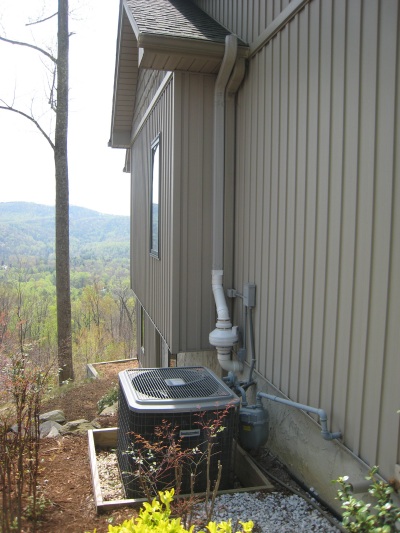 At Blue Ridge Radon Solutions we’re dedicated to helping families and businesses reduce the risk of exposure to harmful radon gas. This dedication drives us to design the most efficient radon mitigation systems while maintaining the highest standards of quality, aesthetics and professionalism. Our qualified technicians have installed hundreds of radon mitigation systems in Western North Carolina. No matter how complex the installation, or how high the levels of radon; we guarantee a solution.
At Blue Ridge Radon Solutions we’re dedicated to helping families and businesses reduce the risk of exposure to harmful radon gas. This dedication drives us to design the most efficient radon mitigation systems while maintaining the highest standards of quality, aesthetics and professionalism. Our qualified technicians have installed hundreds of radon mitigation systems in Western North Carolina. No matter how complex the installation, or how high the levels of radon; we guarantee a solution.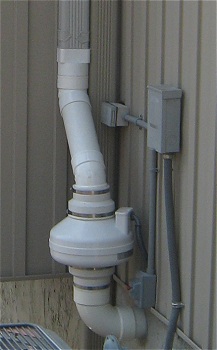 10 REASONS WHY BLUE RIDGE RADON SOLUTIONS IS THE RIGHT CHOICE
10 REASONS WHY BLUE RIDGE RADON SOLUTIONS IS THE RIGHT CHOICE Radon is Serious
Radon is Serious

 Radon gas enters the home through the slab, basement, or crawl space. Pressure differences within the home (from warm air rising and other natural effects) pull radon into living spaces from the soil. Furnace & air conditioning systems can distribute the air through the structure.
Radon gas enters the home through the slab, basement, or crawl space. Pressure differences within the home (from warm air rising and other natural effects) pull radon into living spaces from the soil. Furnace & air conditioning systems can distribute the air through the structure.